Sustainability and Asylum Seekers: Health, Livelihoods, and Australia
VerifiedAdded on 2023/01/20
|9
|2046
|49
Essay
AI Summary
This essay investigates the sustainability challenges concerning the health and livelihoods of asylum seekers in Australia, addressing environmental, social, and economic factors. It begins by defining asylum seekers and refugees, emphasizing the responsibility of host countries to provide adequate living conditions and healthcare, with a focus on Australia's increasing asylum seeker population. The essay explores how housing shortages, rising costs, and limited access to essential services such as healthcare and social programs negatively impact asylum seekers' well-being. It examines the environmental impact of increased population density, pollution, and the effects of climate and weather changes. Social factors, including mental health issues such as anxiety and PTSD, and economic factors, such as limited work opportunities and poverty, are also discussed. The essay proposes solutions, including expediting the asylum application process, establishing settlements in less densely populated areas, and creating employment opportunities. The conclusion highlights the need for policy modifications to improve the quality of life for asylum seekers through sustainable practices that address their health, living conditions, and economic prospects. The essay supports its arguments with references to academic sources and relevant reports.
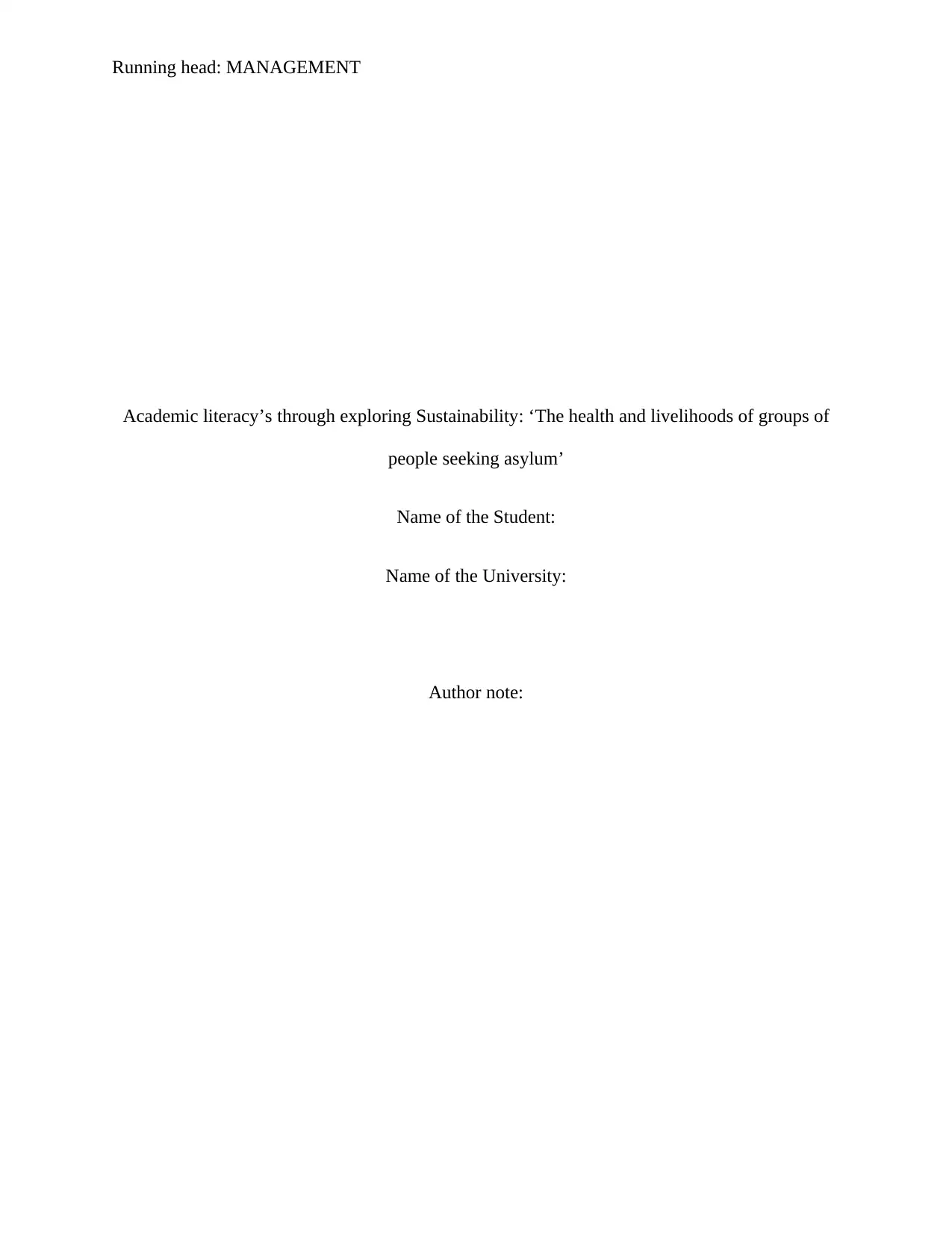
Running head: MANAGEMENT
Academic literacy’s through exploring Sustainability: ‘The health and livelihoods of groups of
people seeking asylum’
Name of the Student:
Name of the University:
Author note:
Academic literacy’s through exploring Sustainability: ‘The health and livelihoods of groups of
people seeking asylum’
Name of the Student:
Name of the University:
Author note:
Paraphrase This Document
Need a fresh take? Get an instant paraphrase of this document with our AI Paraphraser
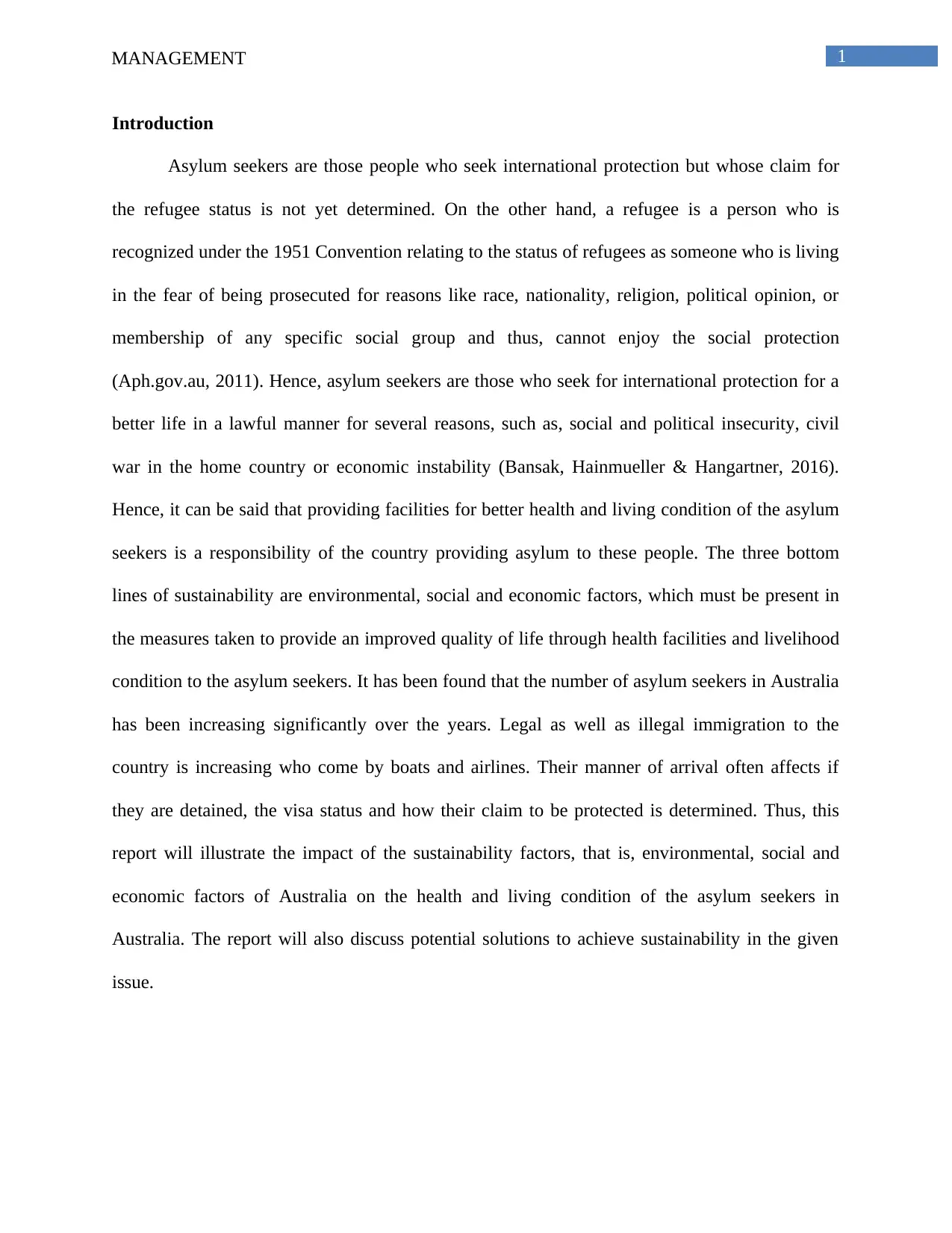
1MANAGEMENT
Introduction
Asylum seekers are those people who seek international protection but whose claim for
the refugee status is not yet determined. On the other hand, a refugee is a person who is
recognized under the 1951 Convention relating to the status of refugees as someone who is living
in the fear of being prosecuted for reasons like race, nationality, religion, political opinion, or
membership of any specific social group and thus, cannot enjoy the social protection
(Aph.gov.au, 2011). Hence, asylum seekers are those who seek for international protection for a
better life in a lawful manner for several reasons, such as, social and political insecurity, civil
war in the home country or economic instability (Bansak, Hainmueller & Hangartner, 2016).
Hence, it can be said that providing facilities for better health and living condition of the asylum
seekers is a responsibility of the country providing asylum to these people. The three bottom
lines of sustainability are environmental, social and economic factors, which must be present in
the measures taken to provide an improved quality of life through health facilities and livelihood
condition to the asylum seekers. It has been found that the number of asylum seekers in Australia
has been increasing significantly over the years. Legal as well as illegal immigration to the
country is increasing who come by boats and airlines. Their manner of arrival often affects if
they are detained, the visa status and how their claim to be protected is determined. Thus, this
report will illustrate the impact of the sustainability factors, that is, environmental, social and
economic factors of Australia on the health and living condition of the asylum seekers in
Australia. The report will also discuss potential solutions to achieve sustainability in the given
issue.
Introduction
Asylum seekers are those people who seek international protection but whose claim for
the refugee status is not yet determined. On the other hand, a refugee is a person who is
recognized under the 1951 Convention relating to the status of refugees as someone who is living
in the fear of being prosecuted for reasons like race, nationality, religion, political opinion, or
membership of any specific social group and thus, cannot enjoy the social protection
(Aph.gov.au, 2011). Hence, asylum seekers are those who seek for international protection for a
better life in a lawful manner for several reasons, such as, social and political insecurity, civil
war in the home country or economic instability (Bansak, Hainmueller & Hangartner, 2016).
Hence, it can be said that providing facilities for better health and living condition of the asylum
seekers is a responsibility of the country providing asylum to these people. The three bottom
lines of sustainability are environmental, social and economic factors, which must be present in
the measures taken to provide an improved quality of life through health facilities and livelihood
condition to the asylum seekers. It has been found that the number of asylum seekers in Australia
has been increasing significantly over the years. Legal as well as illegal immigration to the
country is increasing who come by boats and airlines. Their manner of arrival often affects if
they are detained, the visa status and how their claim to be protected is determined. Thus, this
report will illustrate the impact of the sustainability factors, that is, environmental, social and
economic factors of Australia on the health and living condition of the asylum seekers in
Australia. The report will also discuss potential solutions to achieve sustainability in the given
issue.
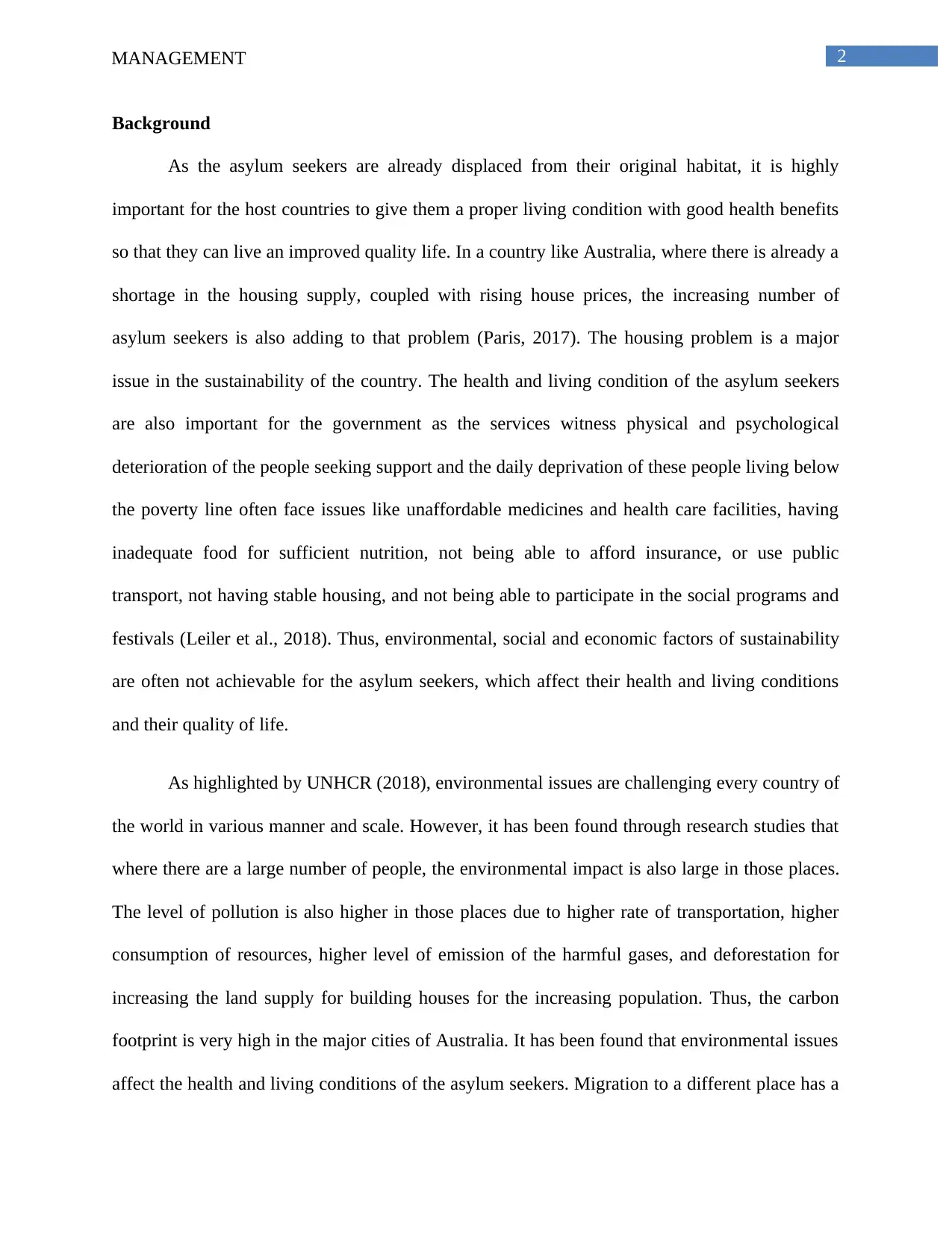
2MANAGEMENT
Background
As the asylum seekers are already displaced from their original habitat, it is highly
important for the host countries to give them a proper living condition with good health benefits
so that they can live an improved quality life. In a country like Australia, where there is already a
shortage in the housing supply, coupled with rising house prices, the increasing number of
asylum seekers is also adding to that problem (Paris, 2017). The housing problem is a major
issue in the sustainability of the country. The health and living condition of the asylum seekers
are also important for the government as the services witness physical and psychological
deterioration of the people seeking support and the daily deprivation of these people living below
the poverty line often face issues like unaffordable medicines and health care facilities, having
inadequate food for sufficient nutrition, not being able to afford insurance, or use public
transport, not having stable housing, and not being able to participate in the social programs and
festivals (Leiler et al., 2018). Thus, environmental, social and economic factors of sustainability
are often not achievable for the asylum seekers, which affect their health and living conditions
and their quality of life.
As highlighted by UNHCR (2018), environmental issues are challenging every country of
the world in various manner and scale. However, it has been found through research studies that
where there are a large number of people, the environmental impact is also large in those places.
The level of pollution is also higher in those places due to higher rate of transportation, higher
consumption of resources, higher level of emission of the harmful gases, and deforestation for
increasing the land supply for building houses for the increasing population. Thus, the carbon
footprint is very high in the major cities of Australia. It has been found that environmental issues
affect the health and living conditions of the asylum seekers. Migration to a different place has a
Background
As the asylum seekers are already displaced from their original habitat, it is highly
important for the host countries to give them a proper living condition with good health benefits
so that they can live an improved quality life. In a country like Australia, where there is already a
shortage in the housing supply, coupled with rising house prices, the increasing number of
asylum seekers is also adding to that problem (Paris, 2017). The housing problem is a major
issue in the sustainability of the country. The health and living condition of the asylum seekers
are also important for the government as the services witness physical and psychological
deterioration of the people seeking support and the daily deprivation of these people living below
the poverty line often face issues like unaffordable medicines and health care facilities, having
inadequate food for sufficient nutrition, not being able to afford insurance, or use public
transport, not having stable housing, and not being able to participate in the social programs and
festivals (Leiler et al., 2018). Thus, environmental, social and economic factors of sustainability
are often not achievable for the asylum seekers, which affect their health and living conditions
and their quality of life.
As highlighted by UNHCR (2018), environmental issues are challenging every country of
the world in various manner and scale. However, it has been found through research studies that
where there are a large number of people, the environmental impact is also large in those places.
The level of pollution is also higher in those places due to higher rate of transportation, higher
consumption of resources, higher level of emission of the harmful gases, and deforestation for
increasing the land supply for building houses for the increasing population. Thus, the carbon
footprint is very high in the major cities of Australia. It has been found that environmental issues
affect the health and living conditions of the asylum seekers. Migration to a different place has a
⊘ This is a preview!⊘
Do you want full access?
Subscribe today to unlock all pages.

Trusted by 1+ million students worldwide
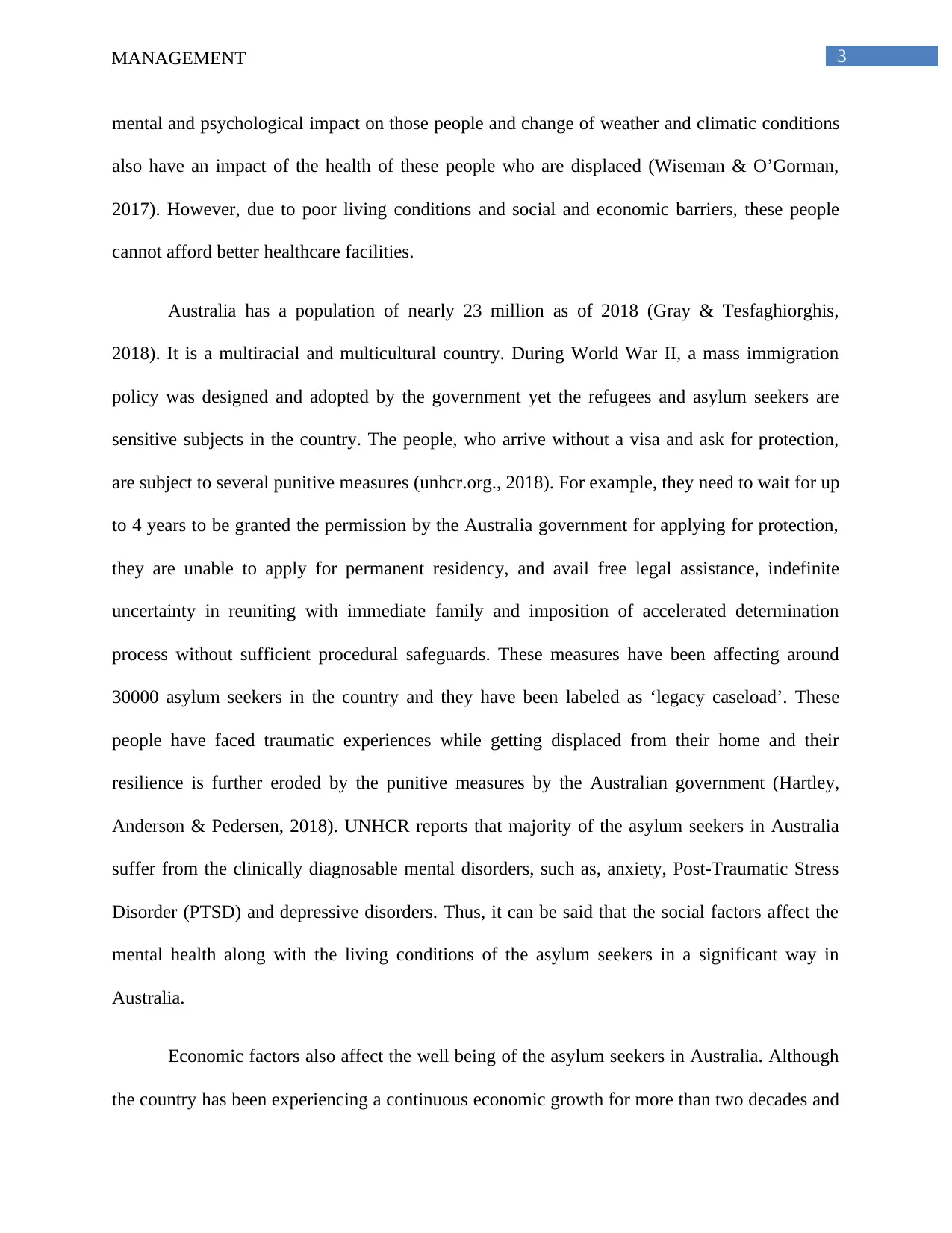
3MANAGEMENT
mental and psychological impact on those people and change of weather and climatic conditions
also have an impact of the health of these people who are displaced (Wiseman & O’Gorman,
2017). However, due to poor living conditions and social and economic barriers, these people
cannot afford better healthcare facilities.
Australia has a population of nearly 23 million as of 2018 (Gray & Tesfaghiorghis,
2018). It is a multiracial and multicultural country. During World War II, a mass immigration
policy was designed and adopted by the government yet the refugees and asylum seekers are
sensitive subjects in the country. The people, who arrive without a visa and ask for protection,
are subject to several punitive measures (unhcr.org., 2018). For example, they need to wait for up
to 4 years to be granted the permission by the Australia government for applying for protection,
they are unable to apply for permanent residency, and avail free legal assistance, indefinite
uncertainty in reuniting with immediate family and imposition of accelerated determination
process without sufficient procedural safeguards. These measures have been affecting around
30000 asylum seekers in the country and they have been labeled as ‘legacy caseload’. These
people have faced traumatic experiences while getting displaced from their home and their
resilience is further eroded by the punitive measures by the Australian government (Hartley,
Anderson & Pedersen, 2018). UNHCR reports that majority of the asylum seekers in Australia
suffer from the clinically diagnosable mental disorders, such as, anxiety, Post-Traumatic Stress
Disorder (PTSD) and depressive disorders. Thus, it can be said that the social factors affect the
mental health along with the living conditions of the asylum seekers in a significant way in
Australia.
Economic factors also affect the well being of the asylum seekers in Australia. Although
the country has been experiencing a continuous economic growth for more than two decades and
mental and psychological impact on those people and change of weather and climatic conditions
also have an impact of the health of these people who are displaced (Wiseman & O’Gorman,
2017). However, due to poor living conditions and social and economic barriers, these people
cannot afford better healthcare facilities.
Australia has a population of nearly 23 million as of 2018 (Gray & Tesfaghiorghis,
2018). It is a multiracial and multicultural country. During World War II, a mass immigration
policy was designed and adopted by the government yet the refugees and asylum seekers are
sensitive subjects in the country. The people, who arrive without a visa and ask for protection,
are subject to several punitive measures (unhcr.org., 2018). For example, they need to wait for up
to 4 years to be granted the permission by the Australia government for applying for protection,
they are unable to apply for permanent residency, and avail free legal assistance, indefinite
uncertainty in reuniting with immediate family and imposition of accelerated determination
process without sufficient procedural safeguards. These measures have been affecting around
30000 asylum seekers in the country and they have been labeled as ‘legacy caseload’. These
people have faced traumatic experiences while getting displaced from their home and their
resilience is further eroded by the punitive measures by the Australian government (Hartley,
Anderson & Pedersen, 2018). UNHCR reports that majority of the asylum seekers in Australia
suffer from the clinically diagnosable mental disorders, such as, anxiety, Post-Traumatic Stress
Disorder (PTSD) and depressive disorders. Thus, it can be said that the social factors affect the
mental health along with the living conditions of the asylum seekers in a significant way in
Australia.
Economic factors also affect the well being of the asylum seekers in Australia. Although
the country has been experiencing a continuous economic growth for more than two decades and
Paraphrase This Document
Need a fresh take? Get an instant paraphrase of this document with our AI Paraphraser
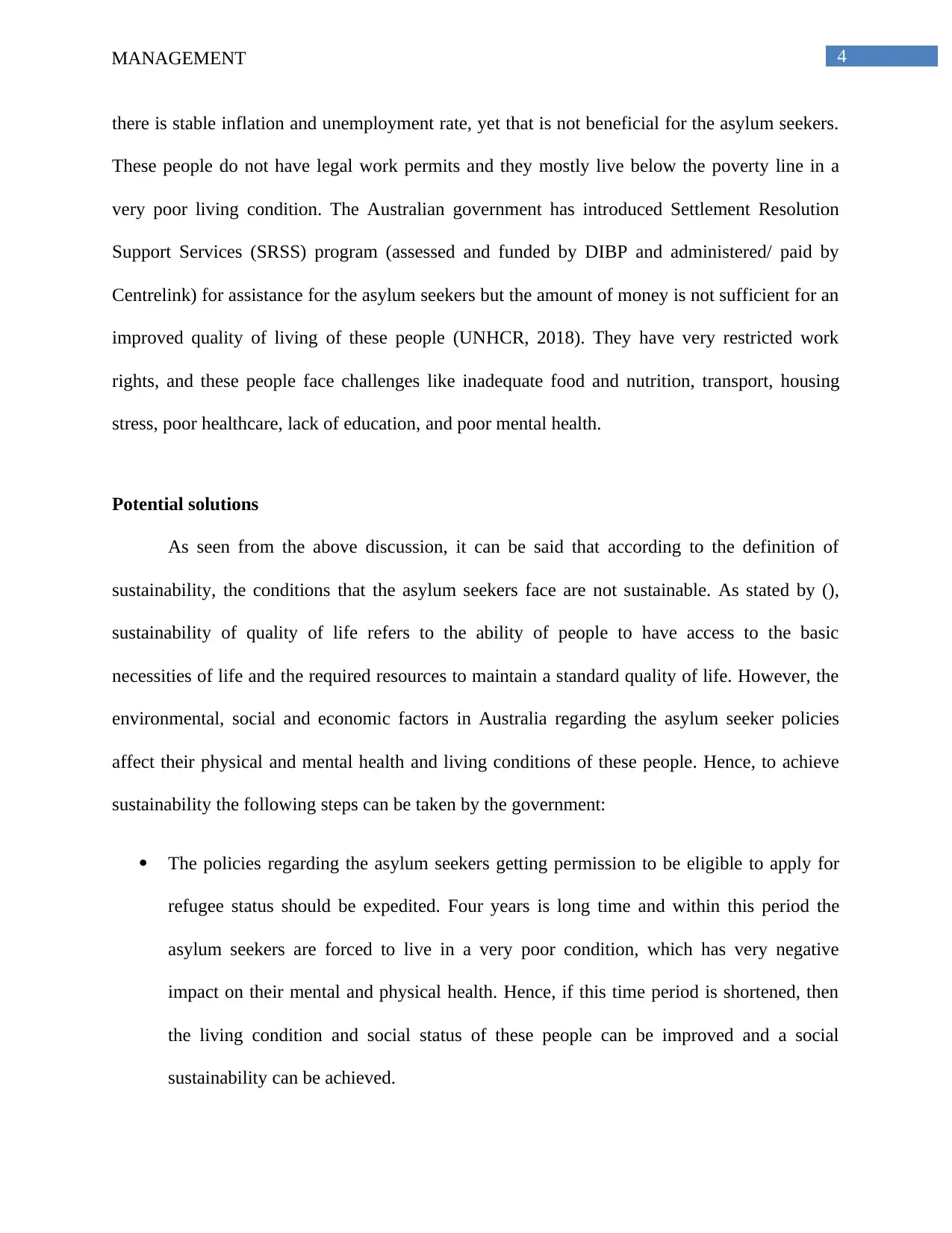
4MANAGEMENT
there is stable inflation and unemployment rate, yet that is not beneficial for the asylum seekers.
These people do not have legal work permits and they mostly live below the poverty line in a
very poor living condition. The Australian government has introduced Settlement Resolution
Support Services (SRSS) program (assessed and funded by DIBP and administered/ paid by
Centrelink) for assistance for the asylum seekers but the amount of money is not sufficient for an
improved quality of living of these people (UNHCR, 2018). They have very restricted work
rights, and these people face challenges like inadequate food and nutrition, transport, housing
stress, poor healthcare, lack of education, and poor mental health.
Potential solutions
As seen from the above discussion, it can be said that according to the definition of
sustainability, the conditions that the asylum seekers face are not sustainable. As stated by (),
sustainability of quality of life refers to the ability of people to have access to the basic
necessities of life and the required resources to maintain a standard quality of life. However, the
environmental, social and economic factors in Australia regarding the asylum seeker policies
affect their physical and mental health and living conditions of these people. Hence, to achieve
sustainability the following steps can be taken by the government:
The policies regarding the asylum seekers getting permission to be eligible to apply for
refugee status should be expedited. Four years is long time and within this period the
asylum seekers are forced to live in a very poor condition, which has very negative
impact on their mental and physical health. Hence, if this time period is shortened, then
the living condition and social status of these people can be improved and a social
sustainability can be achieved.
there is stable inflation and unemployment rate, yet that is not beneficial for the asylum seekers.
These people do not have legal work permits and they mostly live below the poverty line in a
very poor living condition. The Australian government has introduced Settlement Resolution
Support Services (SRSS) program (assessed and funded by DIBP and administered/ paid by
Centrelink) for assistance for the asylum seekers but the amount of money is not sufficient for an
improved quality of living of these people (UNHCR, 2018). They have very restricted work
rights, and these people face challenges like inadequate food and nutrition, transport, housing
stress, poor healthcare, lack of education, and poor mental health.
Potential solutions
As seen from the above discussion, it can be said that according to the definition of
sustainability, the conditions that the asylum seekers face are not sustainable. As stated by (),
sustainability of quality of life refers to the ability of people to have access to the basic
necessities of life and the required resources to maintain a standard quality of life. However, the
environmental, social and economic factors in Australia regarding the asylum seeker policies
affect their physical and mental health and living conditions of these people. Hence, to achieve
sustainability the following steps can be taken by the government:
The policies regarding the asylum seekers getting permission to be eligible to apply for
refugee status should be expedited. Four years is long time and within this period the
asylum seekers are forced to live in a very poor condition, which has very negative
impact on their mental and physical health. Hence, if this time period is shortened, then
the living condition and social status of these people can be improved and a social
sustainability can be achieved.
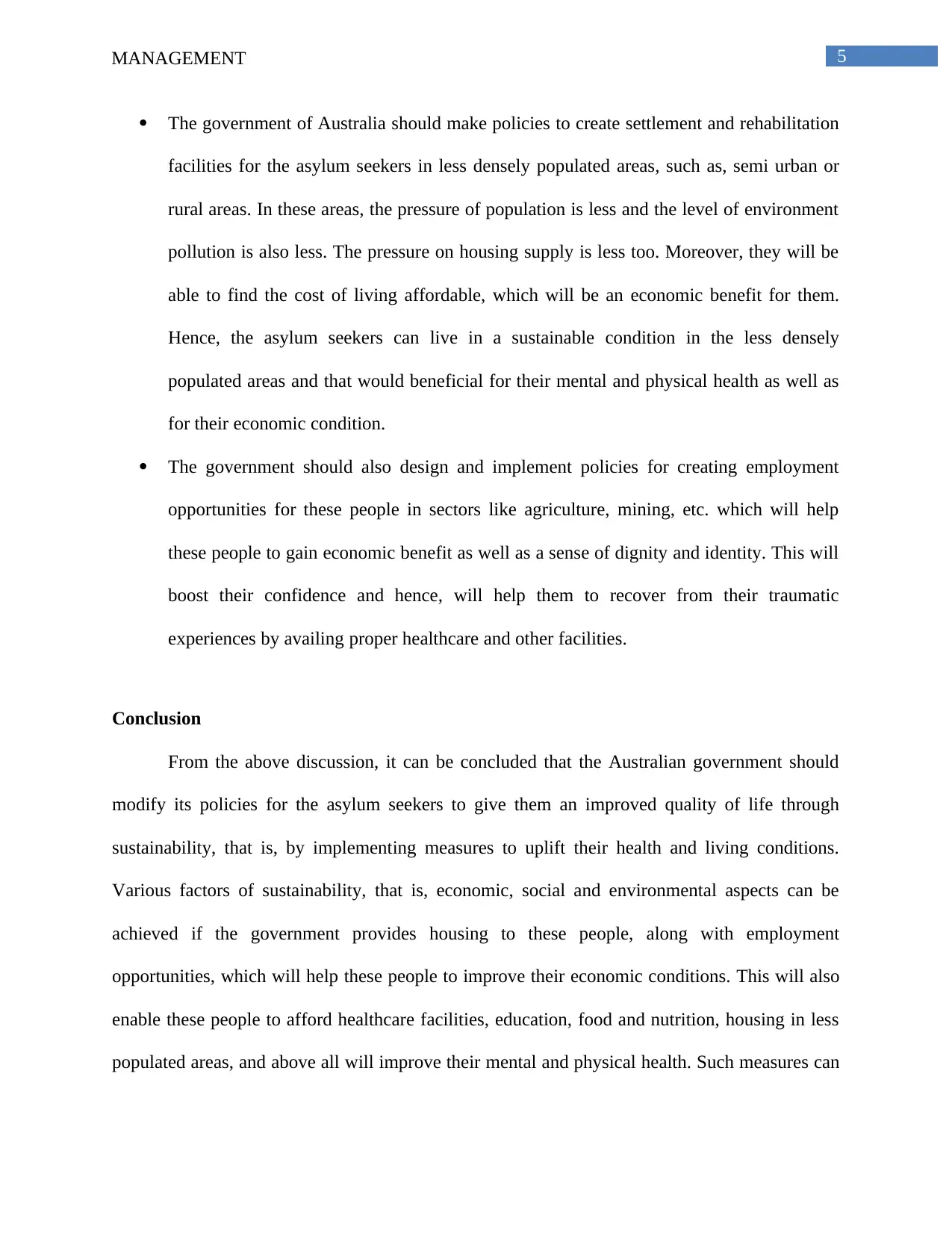
5MANAGEMENT
The government of Australia should make policies to create settlement and rehabilitation
facilities for the asylum seekers in less densely populated areas, such as, semi urban or
rural areas. In these areas, the pressure of population is less and the level of environment
pollution is also less. The pressure on housing supply is less too. Moreover, they will be
able to find the cost of living affordable, which will be an economic benefit for them.
Hence, the asylum seekers can live in a sustainable condition in the less densely
populated areas and that would beneficial for their mental and physical health as well as
for their economic condition.
The government should also design and implement policies for creating employment
opportunities for these people in sectors like agriculture, mining, etc. which will help
these people to gain economic benefit as well as a sense of dignity and identity. This will
boost their confidence and hence, will help them to recover from their traumatic
experiences by availing proper healthcare and other facilities.
Conclusion
From the above discussion, it can be concluded that the Australian government should
modify its policies for the asylum seekers to give them an improved quality of life through
sustainability, that is, by implementing measures to uplift their health and living conditions.
Various factors of sustainability, that is, economic, social and environmental aspects can be
achieved if the government provides housing to these people, along with employment
opportunities, which will help these people to improve their economic conditions. This will also
enable these people to afford healthcare facilities, education, food and nutrition, housing in less
populated areas, and above all will improve their mental and physical health. Such measures can
The government of Australia should make policies to create settlement and rehabilitation
facilities for the asylum seekers in less densely populated areas, such as, semi urban or
rural areas. In these areas, the pressure of population is less and the level of environment
pollution is also less. The pressure on housing supply is less too. Moreover, they will be
able to find the cost of living affordable, which will be an economic benefit for them.
Hence, the asylum seekers can live in a sustainable condition in the less densely
populated areas and that would beneficial for their mental and physical health as well as
for their economic condition.
The government should also design and implement policies for creating employment
opportunities for these people in sectors like agriculture, mining, etc. which will help
these people to gain economic benefit as well as a sense of dignity and identity. This will
boost their confidence and hence, will help them to recover from their traumatic
experiences by availing proper healthcare and other facilities.
Conclusion
From the above discussion, it can be concluded that the Australian government should
modify its policies for the asylum seekers to give them an improved quality of life through
sustainability, that is, by implementing measures to uplift their health and living conditions.
Various factors of sustainability, that is, economic, social and environmental aspects can be
achieved if the government provides housing to these people, along with employment
opportunities, which will help these people to improve their economic conditions. This will also
enable these people to afford healthcare facilities, education, food and nutrition, housing in less
populated areas, and above all will improve their mental and physical health. Such measures can
⊘ This is a preview!⊘
Do you want full access?
Subscribe today to unlock all pages.

Trusted by 1+ million students worldwide
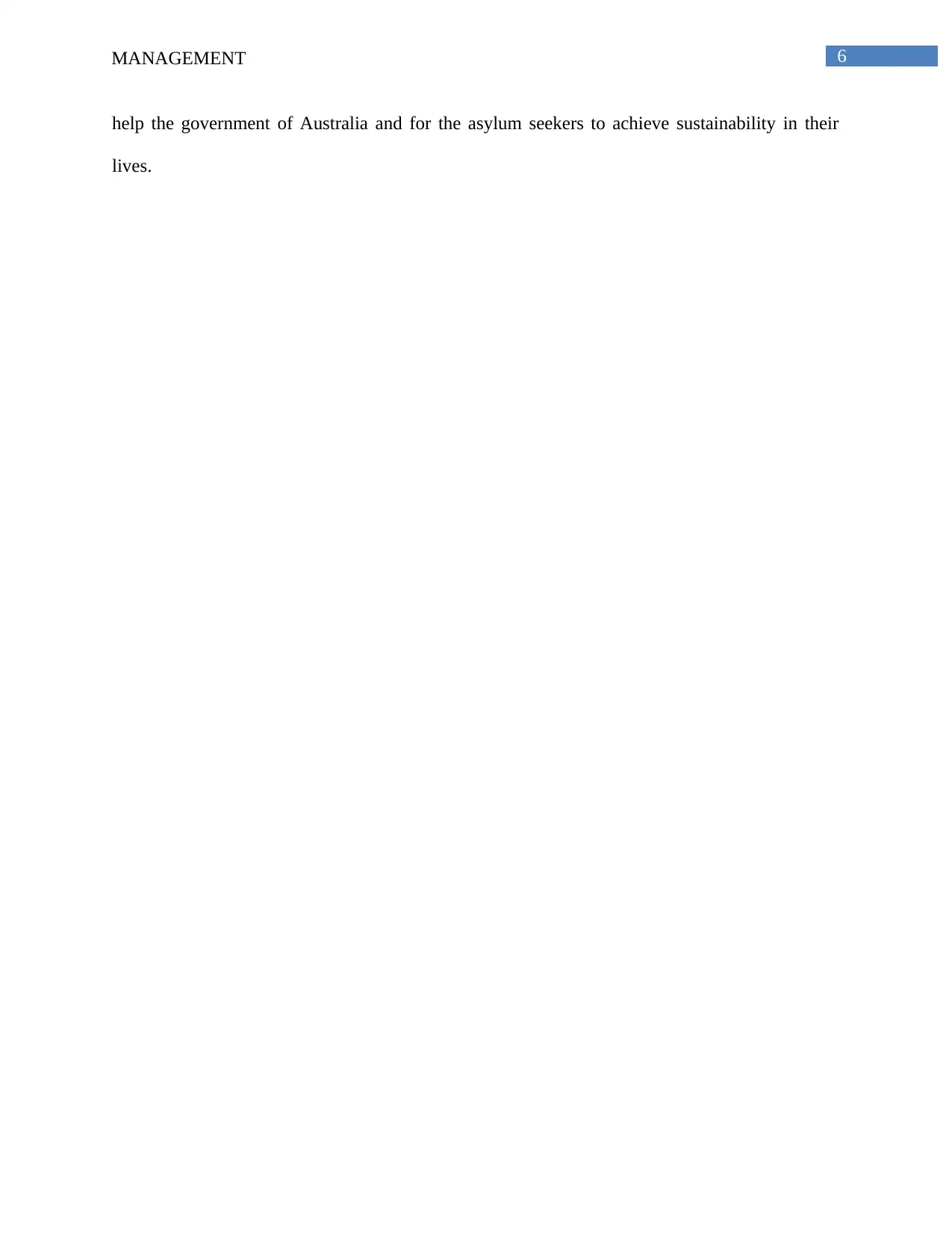
6MANAGEMENT
help the government of Australia and for the asylum seekers to achieve sustainability in their
lives.
help the government of Australia and for the asylum seekers to achieve sustainability in their
lives.
Paraphrase This Document
Need a fresh take? Get an instant paraphrase of this document with our AI Paraphraser
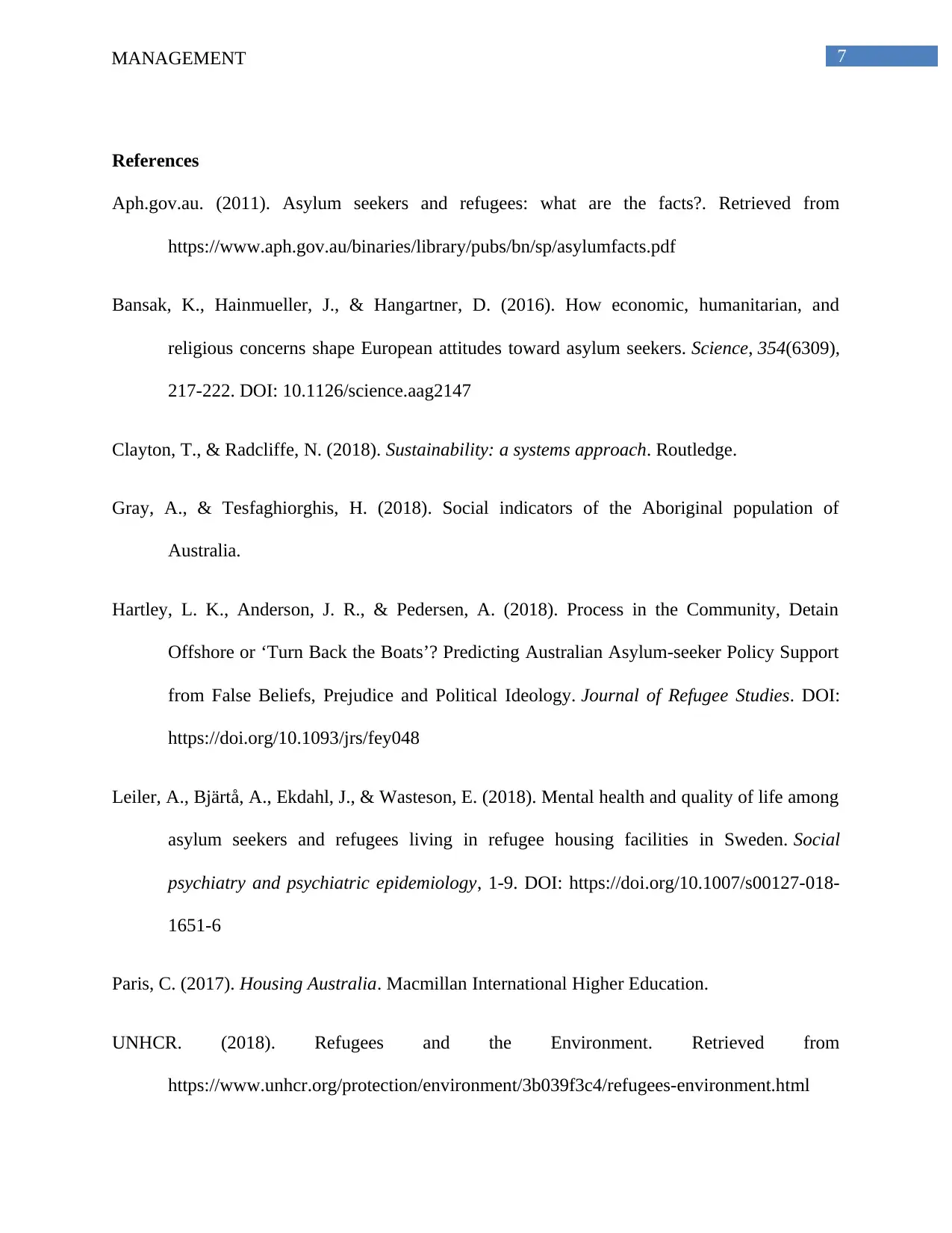
7MANAGEMENT
References
Aph.gov.au. (2011). Asylum seekers and refugees: what are the facts?. Retrieved from
https://www.aph.gov.au/binaries/library/pubs/bn/sp/asylumfacts.pdf
Bansak, K., Hainmueller, J., & Hangartner, D. (2016). How economic, humanitarian, and
religious concerns shape European attitudes toward asylum seekers. Science, 354(6309),
217-222. DOI: 10.1126/science.aag2147
Clayton, T., & Radcliffe, N. (2018). Sustainability: a systems approach. Routledge.
Gray, A., & Tesfaghiorghis, H. (2018). Social indicators of the Aboriginal population of
Australia.
Hartley, L. K., Anderson, J. R., & Pedersen, A. (2018). Process in the Community, Detain
Offshore or ‘Turn Back the Boats’? Predicting Australian Asylum-seeker Policy Support
from False Beliefs, Prejudice and Political Ideology. Journal of Refugee Studies. DOI:
https://doi.org/10.1093/jrs/fey048
Leiler, A., Bjärtå, A., Ekdahl, J., & Wasteson, E. (2018). Mental health and quality of life among
asylum seekers and refugees living in refugee housing facilities in Sweden. Social
psychiatry and psychiatric epidemiology, 1-9. DOI: https://doi.org/10.1007/s00127-018-
1651-6
Paris, C. (2017). Housing Australia. Macmillan International Higher Education.
UNHCR. (2018). Refugees and the Environment. Retrieved from
https://www.unhcr.org/protection/environment/3b039f3c4/refugees-environment.html
References
Aph.gov.au. (2011). Asylum seekers and refugees: what are the facts?. Retrieved from
https://www.aph.gov.au/binaries/library/pubs/bn/sp/asylumfacts.pdf
Bansak, K., Hainmueller, J., & Hangartner, D. (2016). How economic, humanitarian, and
religious concerns shape European attitudes toward asylum seekers. Science, 354(6309),
217-222. DOI: 10.1126/science.aag2147
Clayton, T., & Radcliffe, N. (2018). Sustainability: a systems approach. Routledge.
Gray, A., & Tesfaghiorghis, H. (2018). Social indicators of the Aboriginal population of
Australia.
Hartley, L. K., Anderson, J. R., & Pedersen, A. (2018). Process in the Community, Detain
Offshore or ‘Turn Back the Boats’? Predicting Australian Asylum-seeker Policy Support
from False Beliefs, Prejudice and Political Ideology. Journal of Refugee Studies. DOI:
https://doi.org/10.1093/jrs/fey048
Leiler, A., Bjärtå, A., Ekdahl, J., & Wasteson, E. (2018). Mental health and quality of life among
asylum seekers and refugees living in refugee housing facilities in Sweden. Social
psychiatry and psychiatric epidemiology, 1-9. DOI: https://doi.org/10.1007/s00127-018-
1651-6
Paris, C. (2017). Housing Australia. Macmillan International Higher Education.
UNHCR. (2018). Refugees and the Environment. Retrieved from
https://www.unhcr.org/protection/environment/3b039f3c4/refugees-environment.html
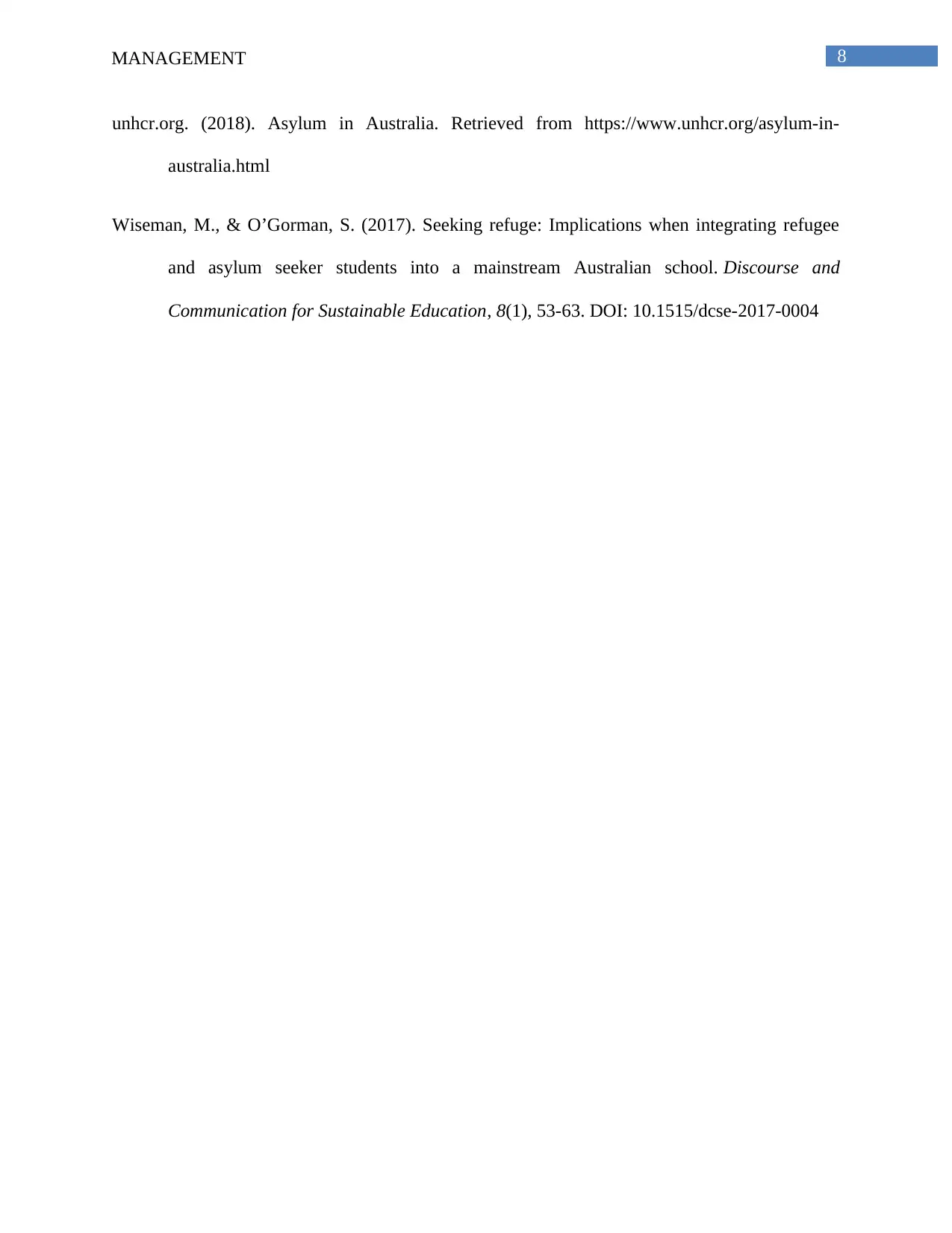
8MANAGEMENT
unhcr.org. (2018). Asylum in Australia. Retrieved from https://www.unhcr.org/asylum-in-
australia.html
Wiseman, M., & O’Gorman, S. (2017). Seeking refuge: Implications when integrating refugee
and asylum seeker students into a mainstream Australian school. Discourse and
Communication for Sustainable Education, 8(1), 53-63. DOI: 10.1515/dcse-2017-0004
unhcr.org. (2018). Asylum in Australia. Retrieved from https://www.unhcr.org/asylum-in-
australia.html
Wiseman, M., & O’Gorman, S. (2017). Seeking refuge: Implications when integrating refugee
and asylum seeker students into a mainstream Australian school. Discourse and
Communication for Sustainable Education, 8(1), 53-63. DOI: 10.1515/dcse-2017-0004
⊘ This is a preview!⊘
Do you want full access?
Subscribe today to unlock all pages.

Trusted by 1+ million students worldwide
1 out of 9
Related Documents
Your All-in-One AI-Powered Toolkit for Academic Success.
+13062052269
info@desklib.com
Available 24*7 on WhatsApp / Email
![[object Object]](/_next/static/media/star-bottom.7253800d.svg)
Unlock your academic potential
Copyright © 2020–2025 A2Z Services. All Rights Reserved. Developed and managed by ZUCOL.





